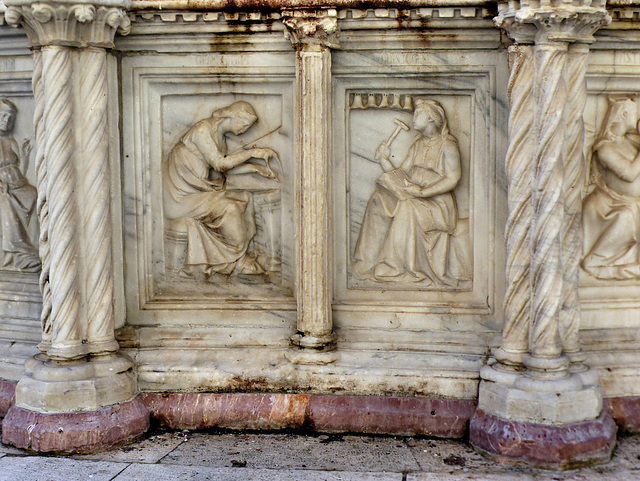walden ex1small
Quando la musica assorbe i tuoi pensieri.. - "W…
Podence - A juventude faz a música
effetto zebra
Acinonyx Short Scale Bass
Iride alla chitarra
Ciudad de la furia - Soda Stereo & Aterciopelados
The Ghetto - George Benson
Willie Clayton - Simply beautifull
Casticais - Ive Mendes
Slow - Rumer
Silvio Rodríguez - En el claro de la luna
Pedro Suarez Vertiz - Lo olvidé
El Gran Combo - A comer pastel, a comer lechón
Los Amigos Invisibles - Si Estuvieras Aquí
Tom Jones - I'll Never Fall in Love Again
Margaret Whiting - I Only Have Eyes For You
Little River Band - Reminiscing
Vente pa Madrid!!
Location
See also...
Keywords
Authorizations, license
-
Visible by: Everyone -
All rights reserved
-
122 visits
Perugia - Fontana Maggiore


Perugia was an Umbrian settlement that became a Roman colonia around 250 BC. In 547 Totila´s Ostrogoth troops looted the city after a long siege. Legends tell, that Perugia´s bishop Herculanus, who negotiated with Totila in behalf of his folks, got beheaded by the Ostrogoths, making St. Herculanus (aka "Sant' Ercolano") to the city´s patron saint.
In the 9th century it passed under the popes, but within the 11th it century gained independency. After a long conflict, in 1370 the city signed a treaty accepting a papal legate, but already 5 years later the vicar-general of the Papal States was expelled by a popular uprising. During the Italian Wars Perugia passed through many hands until Condottiero Braccio da Montone reached a concordance with the Papacy. It did not bring peace to the city, but led to the "Salt War" in 1540, that had started as a protest against paying new taxes on salt. The papal troops forced a surrender.
-
The Fontana Maggiore is located on the "Piazza IV Novembre" (ex "Piazza Grande") between the cathedral (background) and the Palazzo dei Priori (my POV). It was created between 1277 and 1278 by the famous sculptors Nicola Pisano and his son Giovanni Pisano, known for their works in Pisa and Siena.
Once the place was occupied by the bishop´s citadel. After the demolition of the citadel, the fountain got erected here as a symbol of the free city. The Fontana Maggiore is considered one of the finest still existing medieval fountains.
On the twenty-five sides of the lower basin are sculptures representing prophets and saints, the labors of the months, the signs of the zodiac, scenes from Genesis, and events from Roman history.
Here are two of the seven liberal arts ("septem artes liberales"). To the left, holding a compass, is the GEOMETRIA. To the right, playing a carillon, is the MUSICA.
In the 9th century it passed under the popes, but within the 11th it century gained independency. After a long conflict, in 1370 the city signed a treaty accepting a papal legate, but already 5 years later the vicar-general of the Papal States was expelled by a popular uprising. During the Italian Wars Perugia passed through many hands until Condottiero Braccio da Montone reached a concordance with the Papacy. It did not bring peace to the city, but led to the "Salt War" in 1540, that had started as a protest against paying new taxes on salt. The papal troops forced a surrender.
-
The Fontana Maggiore is located on the "Piazza IV Novembre" (ex "Piazza Grande") between the cathedral (background) and the Palazzo dei Priori (my POV). It was created between 1277 and 1278 by the famous sculptors Nicola Pisano and his son Giovanni Pisano, known for their works in Pisa and Siena.
Once the place was occupied by the bishop´s citadel. After the demolition of the citadel, the fountain got erected here as a symbol of the free city. The Fontana Maggiore is considered one of the finest still existing medieval fountains.
On the twenty-five sides of the lower basin are sculptures representing prophets and saints, the labors of the months, the signs of the zodiac, scenes from Genesis, and events from Roman history.
Here are two of the seven liberal arts ("septem artes liberales"). To the left, holding a compass, is the GEOMETRIA. To the right, playing a carillon, is the MUSICA.
- Keyboard shortcuts:
Jump to top
RSS feed- Latest comments - Subscribe to the comment feeds of this photo
- ipernity © 2007-2024
- Help & Contact
|
Club news
|
About ipernity
|
History |
ipernity Club & Prices |
Guide of good conduct
Donate | Group guidelines | Privacy policy | Terms of use | Statutes | In memoria -
Facebook
Twitter

Sign-in to write a comment.